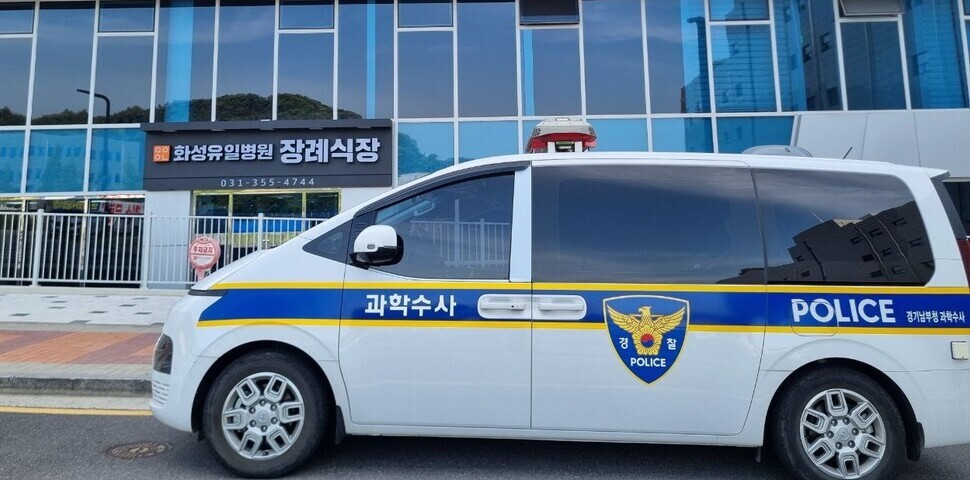hankyoreh
Links to other country sites 다른 나라 사이트 링크
Foreign day laborers make up majority of death toll in Korean battery factory fire

1 pm: One. 4 pm: Nine. 5 pm: Sixteen. 6 pm: Twenty-two.
As the number of those missing in the massive blaze at a primary battery factory in Korea turned into the number of the dead, more and more bodies of laborers were given numbers and transported to funeral homes around Hwaseong on Monday.
The roaring fire ravaged the bodies to the extent that it was impossible to identify even the most basic information about them, such as their gender, so most went unidentified until the evening. Many thought that the identification process would take even longer since most of those killed were migrant workers.
Deafening silence, not the sound of wailing, filled the halls of the funeral homes where the bodies were laid to rest without being reunited with their families or even being named. Each time another round of bodies arrived at the funeral homes, the smell of burning permeated the atmosphere.
“The bodies were burned to the point where it was impossible to tell if they were male or female,” said Lee So-yeong, the manager of Hwaseong’s sanitation policy department who also manages the Hwaseong Hambaeksan Memorial Park, where four of the deceased were brought.
Only government officials and police officers who came to identify the bodies guarded the deserted hallway in front of the morgue.
“All their belongings, including cell phones, were burnt, so we need to do genetic testing, but it will take a long time to find their families and identify them,” said a member of the provincial police agency’s forensic team, who had come to inspect the bodies.

The identification process will take even longer as most of the deceased were migrant workers. As of 6 pm on Monday, police and fire officials said that 18 out of the 22 deceased were Chinese and one was Laotian. Two were South Korean and one was of unknown nationality.
“For the deceased who are foreign nationals, it’ll take longer to confirm their identities and lay them to rest, as we have to take their DNA and compare it with the DNA collected from bereaved families by the relevant embassies to see if they’re a match,” said an official at Hwaseong Yuil Hospital’s mortuary.
According to the Ministry of Employment and Labor, Aricell had no migrant workers on its payroll that were in Korea on the non-professional employment permit system visa (E-9), or the work and visit visa (H-2). However, it may be possible to identify the deceased workers in the case of ethnic Koreans from China, who are permitted to work in manufacturing and other fields while residing in Korea on an overseas Korean visa (F-4), if records remain intact at Aricell’s offices.
“These people were not permanently employed here. They were day laborers dispatched when the need arose,” said Cho Seon-ho, the chief of the Gyeonggi Province’s fire services.
Family and friends of the 50-year-old man who was the first discovered casualty of the fire gathered on Monday afternoon at the Songsan Funeral Home after learning that their loved one had been identified as one of the workers killed in the blaze. Upon seeing other members of the man’s family who had already arrived, both sides broke down into sobs as they embraced one another.
The deceased is known to have been a father to three, laboring in Hwaseong to provide for his family in Cheongju, North Chungcheong Province.
By Yoon Yeon-jeong, staff reporter; Kim Chae-woon, staff reporter; Go Na-rin, staff reporter; Park Tae-woo, staff reporter
Please direct questions or comments to [english@hani.co.kr]

Editorial・opinion
![[Editorial] Silence won’t save Yoon [Editorial] Silence won’t save Yoon](https://flexible.img.hani.co.kr/flexible/normal/500/300/imgdb/original/2024/0701/681719819632087.jpg) [Editorial] Silence won’t save Yoon
[Editorial] Silence won’t save Yoon![[Column] The miscalculations that started the Korean War mustn’t be repeated [Column] The miscalculations that started the Korean War mustn’t be repeated](https://flexible.img.hani.co.kr/flexible/normal/500/300/imgdb/original/2024/0630/9717197068967684.jpg) [Column] The miscalculations that started the Korean War mustn’t be repeated
[Column] The miscalculations that started the Korean War mustn’t be repeated- [Correspondent’s column] China-Europe relations tested once more by EV war
- [Correspondent’s column] Who really created the new ‘axis of evil’?
- [Editorial] Exploiting foreign domestic workers won’t solve Korea’s birth rate problem
- [Column] Kim and Putin’s new world order
- [Editorial] Workplace hazards can be prevented — why weren’t they this time?
- [Editorial] Seoul failed to use diplomacy with Moscow — now it’s resorting to threats
- [Column] Balloons, drones, wiretapping… Yongsan’s got it all!
- [Editorial] It’s time for us all to rethink our approach to North Korea
Most viewed articles
- 1Yoon’s prosecutors are throwing everything at the president’s opponents to see what’ll stick
- 2Japan is building a military meant for more than self-defense — and has the US to thank for it
- 3[Editorial] Silence won’t save Yoon
- 4NewJeans rocks Tokyo Dome as new, younger generation of K-pop fans emerges in Japan
- 5Dreams of a better life brought them to Korea — then a tragic fire tore them apart
- 6[Column] The miscalculations that started the Korean War mustn’t be repeated
- 7[Editorial] Exploiting foreign domestic workers won’t solve Korea’s birth rate problem
- 8S. Korea joins US, Japan for first multi-domain drills at a time of escalating tensions
- 9How million-strong candlelight demonstrations are being organized
- 10[Reportage] Inside N. Korean refugee protection center